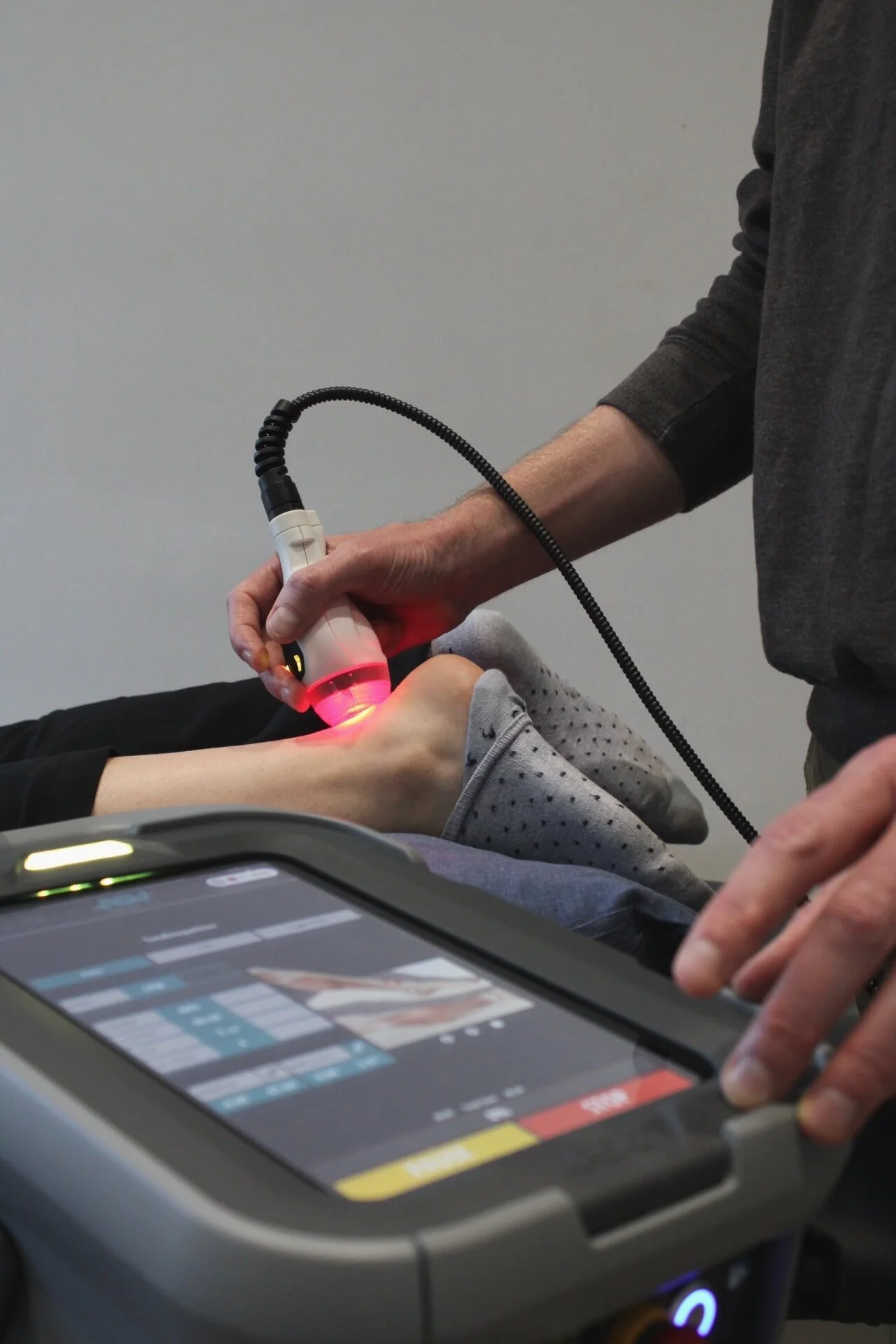Low Level Laser Therapy
Low Level Laser Therapy (Photobiomodulation) in Edinburgh & East Lothian
Gentle light. Real relief.
Low Level Laser Therapy (LLLT), also called photobiomodulation, uses safe, non-heating light to help reduce pain, calm irritation, and support tissue repair in muscles, tendons, and joints. Sessions are quick, comfortable, and can slot straight into your physio plan at The Physiotherapy Place in Portobello and Musselburgh.
Quick summary
Great for: tendon pain (tennis elbow, Achilles), plantar fasciitis, neck/shoulder pain, TMJ, back pain, post-exercise soreness, and some arthritis-related pain.
Feels like: a warm-neutral light on the skin for a few minutes—no needles, no downtime.
Sessions: typically 2–3 per week for 3–5 weeks (often 6–10 sessions total), then taper as symptoms improve. Dosing is based on WALT (World Association for Photobiomodulation Therapy) guidance.
Evidence: research suggests benefits for several musculoskeletal pains when correct dose and wavelength are used; results can vary by condition.
How does low level laser work?
LLLT/photobiomodulation delivers specific wavelengths of light (commonly 780–860 nm or 904 nm) to tissues. Cells absorb this light in their mitochondria, which can:
Modulate inflammation and oxidative stress
Reduce pain signalling
Support tissue repair and microcirculation (reduces swelling)
These biological effects depend on dose, wavelength, and treatment schedule, which is why we follow internationally referenced dosing frameworks (WALT).
What can it help with?
Your physio will advise if LLLT is right for you. It’s commonly used alongside exercise rehab and manual therapy for:
Tendinopathies: tennis/golfer’s elbow, rotator cuff, Achilles tendinopathy.
Plantar fasciitis & heel pain.
TMJ (jaw) pain.
Knee pain & osteoarthritis.
Why combine with physio?
The best outcomes come from pairing LLLT with targeted exercise, manual therapy and load management. Several reviews compare laser plus exercise vs exercise alone and suggest additive benefits in some conditions.
How effective is it?
Overall: Systematic reviews indicate clinically meaningful pain reduction in several musculoskeletal conditions when correct parameters are used.
Knee osteoarthritis: findings vary—some newer analyses suggest pain reduction with 904–905 nm or 785–850 nm, but overall evidence quality is low to moderate and not uniformly positive across trials. We’ll be transparent about likely benefit for your specific case.
Neck/shoulder & soft-tissue pain: multiple reviews report reduced pain and improved function versus sham, particularly with WALT-aligned dosing.
If LLLT isn’t the right fit, we’ll steer you to alternatives such as shockwave, manual therapy, or different exercise progressions.
How many sessions will I need?
Typical plan: 6–10 sessions over 3–5 weeks (2–3 visits/week), then review.
Acute issues: may settle faster (2–6 sessions).
Long-standing pain: may need a longer course, spaced out as you improve.
Our dosing follows WALT recommendations on energy per point and wavelength, tailored to the body area and your skin type.
Is it safe?
LLLT is non-invasive and generally very well tolerated. You’ll wear protective goggles. We avoid use:
over eyes, active cancer sites, pregnant abdomen, photosensitive skin/medications, active infection, or directly over the thyroid.
Your physio will screen you for contraindications.
What happens in a session?
Assessment: we confirm the diagnosis and set goals.
Dosing plan: wavelength/energy set per WALT guidance.
Treatment: light applied to targeted points for a few minutes.
Rehab pairing: you’ll leave with a simple, specific exercise plan to reinforce results.
Prices & booking
LLLT can be added to a standard physio appointment - up to date prices for laser treatment can be found here.
Musselburgh: 18 High Street, Musselburgh — 0131 665 0619
Email: info@thephysiotherapyplace.com • Web: www.thephysiotherapyplace.com
Ready to try low level laser?
Give us a call or an email and we can book you in for your Initial Assessment.
FAQs
Is it painful?
No—most people feel nothing or a gentle warmth. There’s no downtime.
How soon will I notice improvement?
Some feel easier within 1–3 sessions; others build steadily over 3–5 weeks, especially for tendons.
Will it work on its own?
It can, but results are usually better with physio-led exercise and load modification.
Is it the same as “red light therapy”?
Similar principle. We use medical-grade laser/LED devices with precise wavelengths and evidence-informed dosing.
What does the research say overall?
Research supports LLLT for several pains when dosed correctly; some conditions show mixed results across studies. We’ll give honest guidance at your assessment.
It’s with thanks to The UK Government, via East Lothian Council, for the grant that has part funded the purchase of this MLS Laser which has allowed us to stay at the forefront of our profession in offering the people of East Lothian this treatment.

